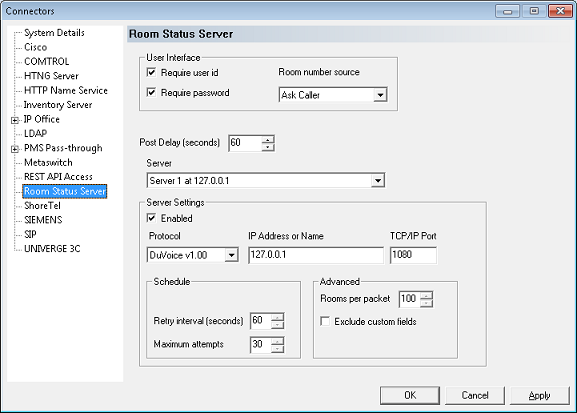|
The Room Status Interface (RSI) is a telephony interface designed to allow housekeeping personnel to report room status to one or more remote servers.
Note: The RSI service is entirely separate from the hospitality service; changes to room status using RSI will not be passed to the PMS via the hospitality server.
Features
| • | PMS integration is not required. |
| • | Mailbox creation and voice mail integration is not required. |
| • | Auto-attendant support is not required (except for providing the telephony interface). |
| • | Unlimited number of user accounts. |
| • | Unlimited number of room status values. |
| • | Telephony interface supports user language preference. |
| • | Web interface supports reporting of all status and user changes. |
| • | System supports posting changes simultaneously to as many as five remote servers. |
Requirements
RSI is a licensed IVR feature and must be purchased from the manufacturer on a per-site basis.
Configuration
To configure the RSI server, run System Configuration and select Features | Connectors from the main menu; then select Room Status Server in the left pane, as shown in the figure below.

Global Settings
The first two settings listed relate to the telephony user interface and are therefore global in effect (that is, it does not matter which server you select from the drop-down list box, these settings are the same for all five servers).
Column
|
Description
|
Require user id
|
Check this box if you want the system to prompt for a user ID at the start of the call.
If this option is disabled, the system will not ask for a password either.
|
Require password
|
Check this box if you want the system to require a valid password after prompting for the user ID.
If the Require user id setting is disabled, the system will never ask for a password, even if this setting is enabled.
|
Room number source
|
Use the drop-down box to select the how the system determines the room number. The options are:
Option
|
Description
|
Ask Caller
|
Select this option to have the system always ask the caller for the room number.
|
Use Calling Party
|
Select this option to have the system use the calling party (caller ID) as received from the PBX.
If the calling party information was not provided by the PBX, then the system will ask the caller for the room number.
|
Use Called Party
|
Select this option to have the system use the called party as received from the PBX.
If the called party information was not provided by the PBX, then the system will ask the caller for the room number.
|
|
Global Settings
This section addresses server-side settings that are global across all servers.
Setting
|
Description
|
Post Delay (seconds)
|
Set the amount time after a change is sent to the RSI before it is posted to all configured servers. Value is in seconds.
Range is 10 to 999 seconds. Default is 60 seconds.
|
Per-Server Settings
Use the drop-down list box at the top to select which of the five possible remote servers you are configuring, then configure the remaining settings for that server:
Column
|
Description
|
Enabled
|
Check this box to enable the selected server.
|
Protocol
|
Use the drop-down box to select the protocol to use for the selected server. Options include:
Option
|
Description
|
DuVoice Version 1.00
|
Select this option if you are using the DuVoice API.
Unless you are using a Comtrol device, you should choose this option.
|
Comtrol
|
Select this option if you are using a Comtrol device.
|
|
IP Address or Name
|
Enter the IP address or server name for the remote server.
|
TCP/IP Port
|
Enter the TCP address to use to connect with the remote server.
|
Retry interval
|
Enter the number of seconds to wait after failing to connect to the remote server before making another attempt.
The default value is 60 seconds.
|
Maximum attempts
|
Enter the maximum number of times to attempt connecting to the remote server before logging a failure.
The default value is 30 attempts.
|
Rooms per packet
|
Enter the number of rooms whose data can be included in a single message packet.
This can be used to limit the packet size if the remote server cannot handle large packets.
The default is 100 rooms.
|
Exclude custom fields
|
Check this box if you want custom fields excluded from the packet.
Default is unchecked, meaning the custom fields will be included.
|
| 




